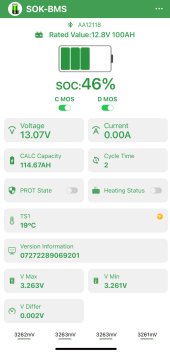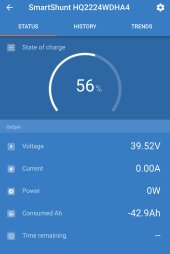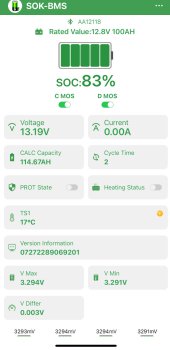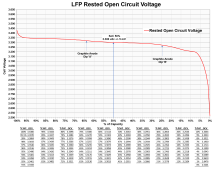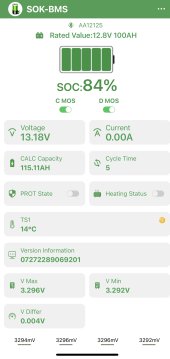Hi folks.
I have a trolling motor that is 36v. I have 3 SOC 100Ah batteries wired in series. I have a Victron SmartShunt on the Neg terminal near the battery.
When I look at the Bluetooth interface between the two management interfaces, there is a discrepancy in the actual power usage.
The batteries were capacity tested...so this 114Ah Capacity is legitimate. But...I'm using 100Ah for all my calculations, including what I set the size of battery for my Smart Shut.
The SOK shows 46% SoC. So I'm calculating that I used 61.56Ah of the batteries capacity. Assuming 46% left of 114Ah as this BMS is using.
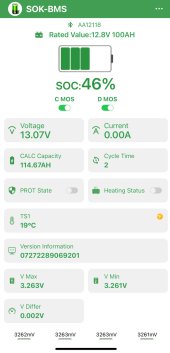
But when I look at the Victron's information, it is showing that I consumed 78.6Ah. The State of Charge %...that is based on a 10% of extra headroom I gave myself. Basically, I set the Smartshut config so that my 0% discharge floor is really set at 15%. I wanted extra so I didn't run the battery down to 0 when on the water. So that percentage on the State of Charge on the Victron...you could add 15% for a full discharge to compare to the SOK's BMS.
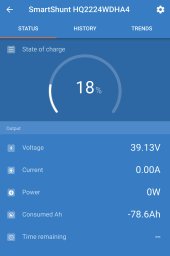
At any rate, the issue I have here is with the CONSUMED Ah numbers.
Victron is saying 78.6Ah. While from the SOK's BMS perspective, it looks to be around 61Ah. Granted, the SOK BMS we have a little interpolation here...because I'm calculating this based on the 114Ah capacity of the battery (remember I load tested this to confirm that is legitimate).
When I used a load tester (one of those cheap off Amazon 150w testers) over the entire battery bank...there was a slight discrepancy between the two. But as the current draw increases it seems like the numbers diverge even more so. I get more Ah drift. Also, the current load (real time) between the two also gets bigger (greater delta) as the load increases.
Any thoughts on why such a discrepancy? Who do I really trust? The Victron or the SOK BMS here?
-J
I have a trolling motor that is 36v. I have 3 SOC 100Ah batteries wired in series. I have a Victron SmartShunt on the Neg terminal near the battery.
When I look at the Bluetooth interface between the two management interfaces, there is a discrepancy in the actual power usage.
The batteries were capacity tested...so this 114Ah Capacity is legitimate. But...I'm using 100Ah for all my calculations, including what I set the size of battery for my Smart Shut.
The SOK shows 46% SoC. So I'm calculating that I used 61.56Ah of the batteries capacity. Assuming 46% left of 114Ah as this BMS is using.

But when I look at the Victron's information, it is showing that I consumed 78.6Ah. The State of Charge %...that is based on a 10% of extra headroom I gave myself. Basically, I set the Smartshut config so that my 0% discharge floor is really set at 15%. I wanted extra so I didn't run the battery down to 0 when on the water. So that percentage on the State of Charge on the Victron...you could add 15% for a full discharge to compare to the SOK's BMS.

At any rate, the issue I have here is with the CONSUMED Ah numbers.
Victron is saying 78.6Ah. While from the SOK's BMS perspective, it looks to be around 61Ah. Granted, the SOK BMS we have a little interpolation here...because I'm calculating this based on the 114Ah capacity of the battery (remember I load tested this to confirm that is legitimate).
When I used a load tester (one of those cheap off Amazon 150w testers) over the entire battery bank...there was a slight discrepancy between the two. But as the current draw increases it seems like the numbers diverge even more so. I get more Ah drift. Also, the current load (real time) between the two also gets bigger (greater delta) as the load increases.
Any thoughts on why such a discrepancy? Who do I really trust? The Victron or the SOK BMS here?
-J



